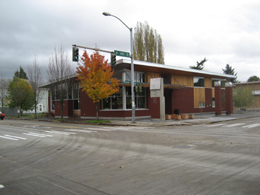Seattle annexed South Park in 1907. But residents had to wait nearly a century before the small working-class enclave across the Duwamish Waterway from Georgetown and Boeing Field got its own public library on September 9, 2006. The new South Park Branch, The Seattle Public Library, at 8604 8th Avenue S was the 20th project completed under Seattle's "Libraries for All" building program. Hundreds of people turned out for the opening.
Early South Park
No sooner had South Park joined Seattle than residents petitioned for a branch library in 1908. The petition, which carried 177 signatures, also identified available land. At the time, South Park was a largely agricultural community where Italian and Japanese farmers raised vegetables and fruits they sold at the Seattle Public Farmers' Market. One of South Park’s most successful growers, Giuseppe "Joe" Desimone (ca. 1880-1946), gradually accumulated property around Pike Place and by 1941 owned the Pike Market Company.
During the early decades of the twentieth century, South Park residents’ only local access to library books was through small, poorly stocked deposit sites that came and went at local pharmacies or grocery stores. Bookmobiles made a brief appearance in 1931, but quickly disappeared because of library budget cuts forced by the Depression.
The closest South Park came to acquiring its own branch library was during World War II, when the library opened several small stations around the city to serve residents who couldn’t easily get to its regular branches. The South Park station opened in 1944, but was closed in September 1947, when bookmobile service was reintroduced.
As the years rolled by, neighboring industrial development encroached on the community. In the 1970s and 1980s, its relatively low housing prices attracted many Latino residents. Residents successfully resisted proposals that the entire neighborhood be zoned for industry. Although crime was a major concern, by the late 1980s, there were unmistakable signs of rejuvenation. A key development was the construction of a community center in 1989.
Despite decades of change, some of it tumultuous, South Park’s desire for its own library branch was a constant. It was the number one priority of the South Park Residential Urban Village 1998 Plan, which stated:
"The South Park Residential Urban Village is not in close proximity to public library services. Residents currently have to travel either to Southeast and West Seattle branch libraries for these services. It is difficult for those South Park residents, especially children and senior citizens, who are dependent on public transit to have convenient access to library services. The South Park area has a multicultural population in need of library, literacy and ESL resources to meet the challenges of the 21st century."
A Library for South Park
Later that year, Seattle residents approved the $196.4 million “Libraries for All” bond issue, and South Park (population 3,717 in the 2000 census) finally was slated for its own branch library. The Seattle Public Library bought property at the corner of 8th Avenue S and S Cloverdale Street and began construction in July 2005. The branch opened on Saturday, September 9, 2006.
The 5,019-square-foot building -- smaller than some community advocates had hoped for -- has capacity for 18,700 books and materials. About one-third of the collection is in Spanish, including bilingual children's materials, and Spanish-language fiction and nonfiction.
Johnston Architects designed the building and Cope Construction Co. built it. The contemporary stucco and cedar-clad building helps create a civic presence in a neighborhood of small restaurants, taverns, and shops that lacks major focal points. A plaza at the corner of 8th Avenue S and S Cloverdale Street provides an outdoor gathering place.
The branch has a large children's area, an alcove for teens, 13 computers for the public, a study room, and parking for 10 vehicles.
“South Park Lights,” a projection-art installation by Seattle artist Franklin Joyce, casts illustrations inspired by community groups on an exterior wall of the building near the entry.
South Park Branch librarian:
Theresa Mayer

